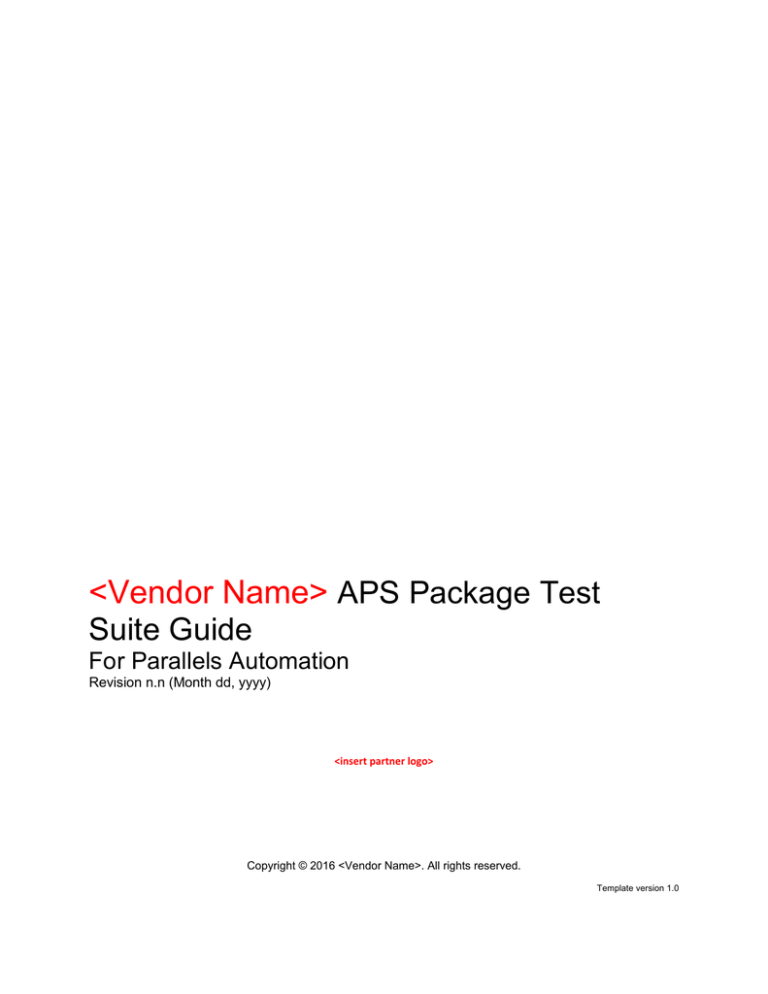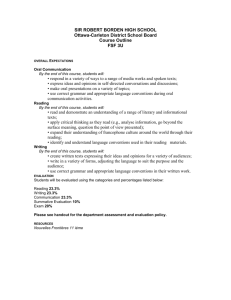
<Vendor Name> APS Package Test
Suite Guide
For Parallels Automation
Revision n.n (Month dd, yyyy)
<insert partner logo>
Copyright © 2016 <Vendor Name>. All rights reserved.
Template version 1.0
Contents
Preface ....................................................................................................................... 4
Documentation Conventions .......................................................................................... 4
Typographical Conventions .....................................................................................................4
General Conventions ...............................................................................................................5
Feedback ....................................................................................................................... 6
Introduction ................................................................................................................. 7
About This Guide ........................................................................................................... 7
Audience ........................................................................................................................ 7
Terms and Abbreviations ............................................................................................... 7
Integration Overview ................................................................................................... 8
APS Package Test Suite Guide .................................................................................. 8
Use Test Cases Example ............................................................................................... 9
Index ......................................................................................................................... 15
CHAPTER 1
Preface
In This Chapter
Documentation Conventions ..................................................................................4
Feedback ...............................................................................................................6
Documentation Conventions
Before you start using this guide, it is important to understand the documentation
conventions used in it.
Typographical Conventions
The following kinds of formatting in the text identify special information.
Formatting convention
Type of Information
Example
Special Bold
Items you must select, such as
menu options, command
buttons, or items in a list.
Navigate to the QoS tab.
Titles of modules, sections, and
subsections.
Read the Basic Administration
module.
Used to emphasize the
importance of a point, to
introduce a term or to designate
a command line placeholder,
which is to be replaced with a
real name or value.
These are the so-called shared
VEs.
Italics
Important
An important note provides
information that is essential to
the completion of a task. Users
can disregard information in a
note and still complete a task,
but they should not disregard an
important note.
To destroy a VE, type vzctl
destroy VEid.
Important: The device
drivers installed
automatically during Setup
are required by your
system. If you remove one
of these drivers, your
system may not work
properly.
Preface
Note
A note with the heading “Note”
indicates neutral or positive
information that emphasizes or
supplements important points of
the main text. A note supplies
information that may apply only
in special cases—for example,
memory limitations, equipment
configurations, or details that
apply to specific versions of a
program.
Note: If Windows prompts
you for a network password
at startup, your network is
already set up and you can
skip this section.
Monospace
The names of commands, files,
and directories.
Use vzctl start to start a VE.
Preformatted
On-screen computer output in
your command-line sessions;
source code in XML, C++, or
other programming languages.
Saved parameters for VE 101
Preformatted Bold
What you type, contrasted with
on-screen computer output.
# rpm –V virtuozzo-release
CAPITALS
Names of keys on the
keyboard.
SHIFT, CTRL, ALT
KEY+KEY
Key combinations for which the
user must press and hold down
one key and then press
another.
CTRL+P, ALT+F4
General Conventions
Be aware of the following conventions used in this book.
• Modules in this guide are divided into sections, which, in turn, are subdivided into
subsections. For example, Documentation Conventions is a section, and General
Conventions is a subsection.
• When following steps or using examples, be sure to type double-quotes ("), left singlequotes (`), and right single-quotes (') exactly as shown.
• The key referred to as RETURN is labeled ENTER on some keyboards.
Commands in the directories included into the PATH variable are used without absolute
path names. Steps that use commands in other, less common, directories show the
absolute paths in the examples.
5
Preface
Feedback
If you have found a mistake in this guide, or if you have suggestions or ideas on how to
improve this guide, please send your feedback <insert Vendor link or e-mail address>.
Please include in your report the guide's title, chapter and section titles, and the fragment
of text in which you have found an error.
6
CHAPTER 2
Introduction
In This Chapter
About This Guide ...................................................................................................7
Audience ................................................................................................................7
Terms and Abbreviations........................................................................................7
About This Guide
This guide describes the test use cases needed to validate that <Vendor Name> is
properly configured and working in a Parallels Automation deployment.
Audience
The audience of this guide is:
• Providers that use Parallels Automation and want to sell <Vendor Name> services to
customers.
Terms and Abbreviations
• APS - Application Packaging Standard, an open standard that was designed to simplify
the delivery of SaaS applications in the cloud-computing industry.
• PA - Parallels Automation, which includes both POA and PBA.
• PBA - Parallels Business Automation.
• POA - Parallels Operations Automation.
• CCP - Customer Control Panel provided by Parallels Automation
• Add <Vendor Name> terms and abbreviations
CHAPTER 3
Integration Overview
This section contains an outline of how the integration of <Vendor Name> and PA is
consumed by the end customer.
<insert product integration overview>
<>
APS Package Test Suite Guide
Goal – A test procedure to exercise every point of functionality enabled by an APS
package.
Use – Certification for “works on Parallels Automation” and for Parallels Automation
partners to verify deployment.
As a starting point, each service in a package’s service hierarchy will need a create,
disable, enable, and remove use test case. The options exposed by each sub service
will add to the number of test cases needed. For example, the “Example Service” APS
package allows for two different User License types to be provisioned. One for Servers
and one for Desktop licenses. These options necessitate additional test use cases to
test provisioning of each at the User level with additional test cases down the chain for
User Quota provisioning across the different User License types. Testing the full
hierarchy with the full complement
of options will help uncover bugs
related to service setting scope
errors not uncovered during
development.
In this example, four service levels
have been implemented requiring a
use test case of create, disable,
enable, and remove for each level
APS Package Test Suite Guide
resulting in a minimum of sixteen use test cases. Upgrade and downgrade use test
cases should be included if the APS package allows the customer to do upgrades or
downgrades.
Each use test case should have a form completed based on the sample below. Each
form should contain the description of the process needed to properly complete the
process in question. Any additional information needed by the tester should also be
included covering special settings or circumstances to be tested.
Use Test Cases Example
1. SProSMB
a. Create
b. Disable
c. Enable
d. Remove
e. Upgrade?
f. Downgrade?
2. ProUser
a. Create
b. Disable
c. Enable
d. Remove
e. Upgrade?
f. Downgrade?
3. SMBUserLicenses
a. Create
b. Disable
c. Enable
d. Remove
e. Upgrade?
9
APS Package Test Suite Guide
f. Downgrade?
4. SMBUserQuota
a. Create
b. Disable
c. Enable
d. Remove
e. Upgrade?
f. Downgrade?
Using this approach to define the use test cases has resulted in 24 tests. Some
applications will not have the ability to upgrade/downgrade. Others might not have as
deep of a service hierarchy resulting in fewer test cases. Unique offerings by some
applications could require still more use test cases, this approach should only be used
as a starting point.
10
APS Package Test Suite Guide
SAMPLE #1
Test #:
2a
Package
Version:
S Pro 1.2
Build:
34
Date:
Oct 10, 2012
The SPro SaaS to support the creation of customer organization with specified number of computers,
assigned backup storage size and specified type of service:
Product
Description:
External tracking number:
Test Case
Title:
Test Purpose:
Create SPro Subscription for customer.
Preconditions:
Customer must be created. SPro service plan must be available to subscribe on provider side.
Procedure:
Login to Customer’s CP;
On “Account” tab click “Subscriptions”;
Click “Buy New Subscription”;
Choose “Category” , “Service Plan”, ”Period”, skip “Domain Name” choosing, click “Place Order”;
On “Account” tab click “Subscriptions”, wait till chosen subscription will be in status “Active” and “Running”.
Expected
Results:
Subscription with “SPro” provisioned successfully.
Results:
P
Customer’s administrators will be able to signs up for SPro service.
Subscription with “SPro” provisioned successfully.
Reason for
Failure/ Error
Msg:
Test Parameter Details (notes on exact components used)
Service Plan
SPro Pro Gold
Service Template
Reseller Name
Customer Name
Customer Username
Customer Password
Joe Tester
empresarial
1qw34r
Tested By:
Special
Instructions:
SAMPLE #2
11
APS Package Test Suite Guide
Test #:
3d
Package
Version:
SPro 1.2
Build:
34
Date:
Oct 10, 2012
The SPro SaaS to support the creation of customer organization with specified number of computers,
assigned backup storage size and specified type of service
Req Desc:
External tracking number:
Test Case
Title:
Test Purpose:
Remove a license from a customer.
Preconditions:
Customer must be created. SPro service plan must be available to subscribe on provider side. The customer
has an active license with quota assigned.
Procedure:
Login to Customer’s CP;
On “SPro” tab click “Subscriptions”;
Click “Manage” next to the count of licenses;
Choose a license in the list and click “delete”;
Verify that the license removal correctly releases the license and quota on SPro’s system and the customer’s
account.
Wait for the delete process to run and verify that the license is removed from the list.
License is removed from the customer account and from SPro’s system.
Expected
Results:
Results:
P
License was removed from the customer’s account and from SPro’s system.
Reason for
Failure/ Error
Msg:
Test Parameter Details (notes on exact components used)
Service Plan
Service Template
Reseller Name
SPro Gold
Tested By:
Special
Instructions:
12
Andy Christ <andy@parallels.com>
Customer Name
Customer Username
Customer Password
Joe Tester
empresarial
1qw34r
APS Package Test Suite Guide
TEMPLATE
Test #:
Package
Version:
Build:
Date:
Req Desc:
External tracking number:
Test Case
Title:
Test Purpose:
Preconditions:
Procedure:
Expected
Results:
Results:
P
Reason for
Failure/ Error
Msg:
Test Parameter Details (notes on exact components used)
Service Plan
Service Template
Reseller Name
Customer Name
Customer Username
Customer Password
Tested By:
Special
Instructions:
13
APS Package Test Suite Guide
14
Index
Index
<Update to appropriate terms and
pages>
A
About This Guide - 7
Audience - 7
D
Documentation Conventions - 4
F
Feedback - 6
G
General Conventions - 5
I
Integration Overview - 8
Introduction - 7
P
Preface - 4
T
Terms and Abbreviations - 7
Typographical Conventions - 4





